|
Born and raised in a tropical island of Puerto Rico awoke my curiosity and interest for understanding air quality, climate and weather patterns. Every year we experience African Dust incursion, which degrades the air quality and affected me personally due to my asthma restricting me to indoor activities. Also, a tropical cyclone strikes Puerto Rico almost every year (ironically, yesterday night tropical storm Erika passed). At an early point in my studies, I identified atmospheric chemistry as an important research topic to me. Since high school, I started to explore the chemistry research and how it could be translated my laboratory bench knowledge to real life situations. Right before entering to college, I participate in the NOAA-CAS Weather Camp at Howard University. I was amazed to realize that studying atmospheric science was not only doing forecast sitting on a computer. After that I started dreaming of the day that I could apply my chemistry knowledge to environmental studies. I thought that I would have to wait until graduate school. However, it took less than two years to combine both passions and start performing atmospheric chemistry research at my undergraduate institution (University of Puerto Rico, Río Piedras). In order to complement it, I started to explore different aspects of atmospheric chemistry research by participating in two NSF-REU programs (which are great and truly recommended to everyone). And now I am at Texas A&M Univesity doing my PhD on this subject. The topic that caught my immediate attention due to its broader implications was atmospheric aerosols. Atmospheric aerosols, liquid or solid particles suspended in the air (Figure 1), are formed by chemical reactions or directly emitted into the atmosphere from both natural and anthropogenic (human induced) sources. Aerosols influence the Earth’s radiative balance, impact cloud nucleation processes, reduce visibility, alter global biogeochemical cycles, and impair air quality and human health. In particular, aerosols play a critical role in climate directly by scattering and absorbing solar radiation, and indirectly through modifying cloud properties by acting as cloud condensation nuclei and ice nuclei. Currently, the direct and indirect effects of aerosols represent the largest uncertainty in climate predictions using global climate models (Figure 2). A full understanding of aerosols and their role in the atmosphere requires a detailed physico-chemical characterization (such as mass, size, concentrations, chemical composition, and optical properties). Reducing this gap in knowledge, will lead to significant implications for the development and improvement of climate-related policies and risk assessments worldwide. Climate Change and Air Quality are usually treated as independent issues, while in fact they are highly correlated, as the Figure 3 shows. I had the opportunity to travel to Beijing, China during the past winter. Beijing has a serious air quality problem due to its pollution of gasses and aerosols (check future blogs for further details). Furthermore, this pollution undergoes long-range transport reaching other countries, making it a global problem as well. Therefore, climate change its everybodies problem and increasing awareness is a goal of this program. Climate Change is a controversial political topic, with discussions often not based on scientific data; thus we want to promote its literacy on a broader context to the community so that informed opinions can be made. I am extremely excited to attend the COP 21, because I will be able to learn about the socio-political and economical points of view from other countries regarding climate change that I can then share. Also, this experience will help me in countless ways to combine my scientific training, educational development and science policy concepts for a formal and informal education. Please join me in this adventure and follow us on our different social media platforms. 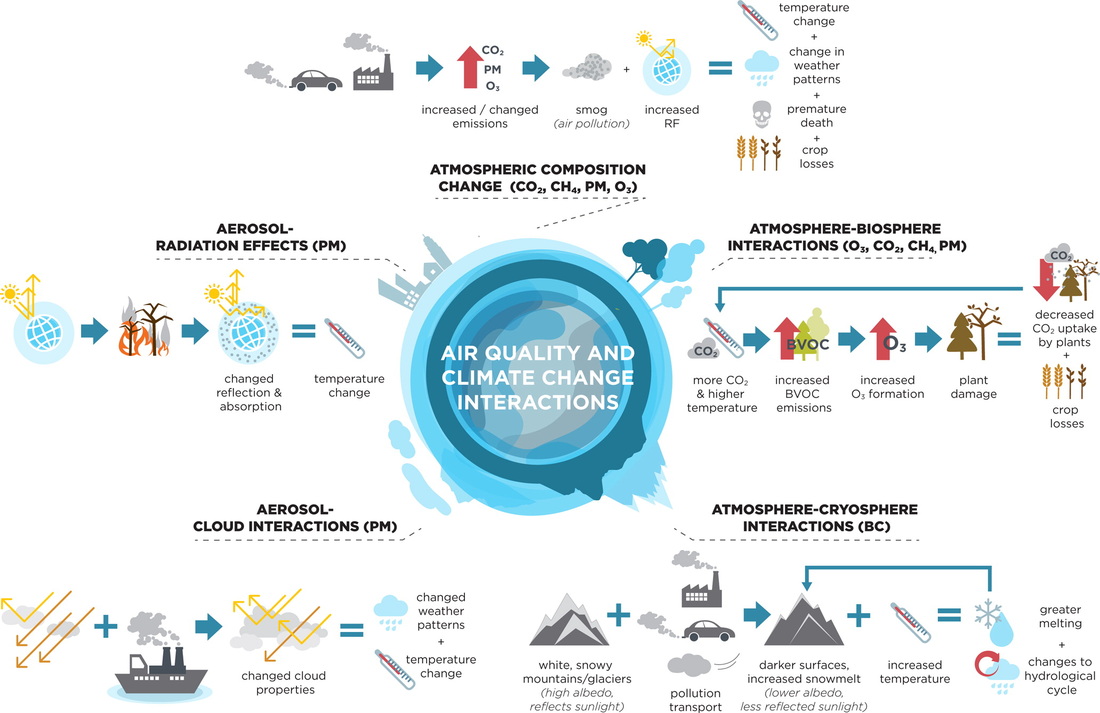 Figure 3: An overview of the main categories of air quality and climate change interactions including a depiction of an example interaction or feedback for each category. [Von Schneidemesser, E. et al. Chemistry and the Linkages between Air Quality and Climate Change. Chem. Rev., 2015, 115 (10), pp 3856–3897]
1 Comment
It was my graduate advisor that first pointed out the irony: the same passion that motivated me to become a Peace Corps Volunteer, to live in rural Panama with no electricity and no cell phone service for two years, is motivating me to go to Paris, a well known tourist destination with five star hotels. That passion, of course, is climate change. 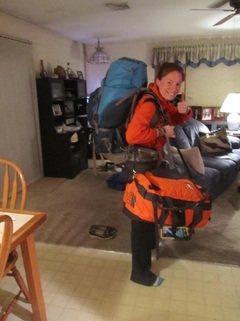 Everything I brought with me to Panama. Everything I brought with me to Panama. I can’t pinpoint the moment when I decided I wanted to dedicate my education, my career, to climate change, but I do know that living and working in Panama solidified this goal. I spent my four years as an undergrad taking a variety of science classes, from chemistry 101, to watershed hydrology, to environmental planning and policy. I left undergrad knowing I wanted to be a Peace Corps Volunteer, knowing I wanted to work in the environmental field, and knowing I would eventually have to attend graduate school, but I still had no idea WHAT I would study in graduate school. In January of 2012 I packed up my life into a few bags, and headed to Panama with the exceptionally vague title of "Community Environmental Conservation Extension Agent." Now, as all my friends (who probably now cringe every time I say "This one time in Panama. . .") know, it is impossible to sum up my two year Peace Corps experience in a few sentences. But what I want to focus on here, is one of my major projects in Panama: Eco-stoves. 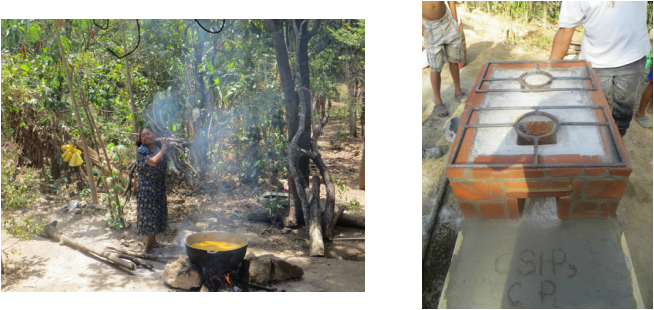 Left: Traditional cooking method. Right: One of the family size eco stoves we built. CSIP stands for Cosecha Sostenible Internacional (Sustainable Harvest International) which is an NGO that supported my project. CP stand for Cuerpo de Paz (Peace Corps). Left: Traditional cooking method. Right: One of the family size eco stoves we built. CSIP stands for Cosecha Sostenible Internacional (Sustainable Harvest International) which is an NGO that supported my project. CP stand for Cuerpo de Paz (Peace Corps). So, what in the world is an eco-stove? In Panama women traditionally cook by placing a large pot on top of a few rocks, and light a fire underneath the pot. This method is not very efficient because a lot of heat escapes and requires a great deal of firewood which causes immense amounts of deforestation. The traditional cooking method also emits a great deal of smoke which has negative health impacts. This is where eco-stoves come in. Eco-stoves enclose the flame, causing the fire to burn hotter and emit less smoke making the cooking process more efficient (and in turn requiring a lot less firewood). To complete this project I received a nearly $2000 grant from the Environment and Climate Partnership of the Americas, an organization that gives funds for projects that help mitigate climate change. With this money, and a lot of effort from community members, we built 30 eco-stoves. While my community members loved the stoves, and these stoves do help mitigate climate change by reducing deforestation, I had a revelation during this process. The members of my small, 300 person community in rural Panama, while feeling the impact of climate change (in the death of coffee trees and increased plagues on their orange trees, in changes in the length of the rainy season etc.), are contributing very little to the cause of climate change. And this community is not an anomaly; across the globe the people who are experiencing some of the worst effects of climate change, are those contributing the least to the source of the changing climate. While I am proud of the stoves I helped my community build, and I believe that change at the grassroots level is an important component to combatting climate change, grassroots initiatives alone will not solve the problem. Climate change also needs to be addressed at an international level. This is why I have chosen to focus my masters research on how incorporating different knowledges can benefit climate change policy and management plans, and why I am excited to attend COP 21. Attending COP 21 is giving me the opportunity to learn more about international efforts, and share these efforts with others! I am excited to be part of an amazing and diverse group of student delegates, keep reading our blog, like us on Facebook and follow our instragram and twitter to take the journey with us!! 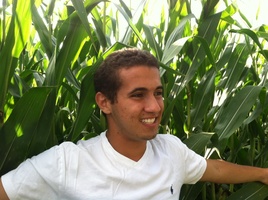 Straight out of the cornfields and back into more cornfields: My name is Greg Margida from Alliance, Ohio and I am a senior at Grinnell College in Grinnell, Iowa. I am majoring in Biology and French. I plan to go to medical school, even though much of my undergraduate work has dealt more with ecology. In northeast Ohio, I was always within a mile of an oil well. They littered every landscape like grazing metal horses. Soon the oil wells were replaced with fracking, the closest site being just a half mile down the road from me. Needless to say, I was raised in an environment that was not very focused on sustainable energy. The truth is, I never even knew the dangers of fracking until after I went to college: all of the CO2 that is released into the atmosphere while transporting the 1-8 million gallons of water needed at each site, the methane gas that leaks from the fracturing site into the water supply, not to mention all of the carcinogens and other harmful chemicals that are left in the ground. People back home don’t really see fracking like this, though. They see it more like utilizing a resource and creating jobs, never fully considering all of the dangers it poses to our environment and to us. It was refreshing when I got to Grinnell and got to work with other students who want to take action to protect the environment. Who don’t deny that climate change is real. In fact, the whole state of Iowa, not just Grinnell College, is actually seemingly steps ahead of Ohio in sustainable energy. One baby step is ethanol. Iowans love ethanol. Mostly, they love it because corn is everywhere out here and it seems like a great idea to put it to use for fuel. Unfortunately, ethanol is really not too much better for the environment than gas due to the large amounts of fossil fuels used to make and transport it. Still, Iowans should be given credit for simply acknowledging that a replacement for fossil fuels is needed. A much bigger step that Iowa has taken is visible across much of the northwestern portion of the state. This summer, I drove to Lake Okoboji in Northwest Iowa to run the Okoboji Marathon. During the trip I was in awe of the massive wind farms I drove through, each seeming to have hundreds of colossal units. Anyone who has tried to walk anywhere during the Iowa winter knows too well how windy Iowa is. And what a beautiful site to see all of this turned into energy we can use, not to mention the jobs it creates. So that has been my climate change journey thus far. And I cannot wait for it to continue throughout my COP21 experience. Let’s get to work! For more information on fracking, visit http://www.dangersoffracking.com. Credit: http://www.dangersoffracking.com/
Hey everyone! My name is Gilbert Vial and I'm a senior forensic chemistry major at York College in York, PA. I grew up in Columbia, Maryland. Growing up here, we never heard much about Climate Change, most of my science classes were filled with Bill Nye. (Sorry about getting the song stuck in your head!) I didn't have a strong interest in climate change until I started studying chemistry in college. My advisor and professor for my Ethics seminar had us working on different videos to help explain climate change to younger children, students our age and our parents generation. Working with that professor, I had a stronger exposure to different areas of the climate change science, from polar bears, to CO2, and I'm still extremely interested in learning more about climate change and I am so excited for the opportunity to learn more. With that being said I plan on passing on what I learn so that students who didn't have a strong exposure can quickly "catch up" and help to prevent any more damage to our planet. I really believe it's up to our generation and the coming ones to turn this around. Like I said earlier, Bill Nye was my first exposure to science, here's a video of him explaining climate change with emojis, the critical part is getting younger generations involved early! Hello everyone! I’m Chris, currently a senior Chemistry major at Saint Edward’s University in Austin, Texas. As I’m preparing for my senior year of college, I’ve been looking back a few years and would never have imagined that I would be so lucky to be an ACS student representative at COP21. Growing up in California, sustainability and climate change were topics I had always heard about, but never had a real interest in. Coming to Texas for college was a big change. Granted, Austin is very different from the rest of the state and much more on board with being sustainable and energy efficient, but I still found myself having to make more of an effort to work to live sustainably as a college student. For example, one of my pet peeves is still the ridiculous amount of unnecessary paper handouts and flyers I’ve received in college! I started considering climate change from a global perspective after an internship I had last summer (2014) through the Department of Energy at the Stanford Linear Accelerator Center National Laboratory (SLAC). Working on solar cells and seeing other renewable energy technologies being developed there, I became passionate about using my research chemistry background to work towards more sustainable energy. With that experience, this summer I was an intern at the NASA Marshall Space Flight Center, synthesizing aerogels as catalyst supports for carbon dioxide reduction. While it was primarily intended for use on the International Space Station and for long-term space missions/inhabitation, it also has potential applications here on Earth to reduce our carbon dioxide emissions as well.
Hi Everyone! My name is Prakriti and I am originally from Kathmandu, Nepal. I am currently a senior majoring in Biology at Grinnell College in Iowa. This summer I am researching lupus genetics at the Mayo Clinic in Rochester, MN. I am incredibly excited to be a student representative for the American Chemical Society at the 21st annual United Nations Framework Convention on Climate Change Conference of Parties (COP21). The COP21 will take place in Paris, France this December and I will try to keep you updated on all the events and activities through this blog as well as other social media sites. My interest in being an ACS student delegate at COP21 is a culmination of my experiences growing up in Nepal and my academic explorations of climate change in college. I became interested in learning about protecting the environment at a young age. My grandmother would tell me stories about the clean and holy Bagmati River that flowed through the city during her childhood. As a native of Kathmandu, the capital and most ‘developed’ city of Nepal, I frequently passed the Bagmati River. Years of dumping waste into this holy river had led to the creation of a foul-smelling and repulsive body of water. While I held my breath every time I passed this river, it pained me to see that humans could be so destructive. I wanted to learn how to prevent such destruction. The school I went to in Nepal instilled a sense of awareness about the environment in me. We celebrated environment day every year, during which everyone had to dress in one of the earth colors, green, glue or brown and each class was responsible for a fun environment-related activity. During the year, we were taught to do small things like dispose of waste properly, recycle paper and cans, as well as reuse plastic bags. At home, we use solar power for hot water and we have a wastewater plant. As a teenager, I complained a great deal about not being able to take a hot shower on a cloudy day, or not being able to wash my clothes in a washing machine due to the shortage of water in our city. I am thankful I grew up in the developing world where I had to learn to live with limitations on water, gas and electricity because it showed me that we could survive without being wasteful. Attending college in the US has been a wonderful experience and made me even more appreciative of our environment. I have gotten the opportunity to explore the effect of climate change on organisms, learn about prairie restoration, been in the midst of passionate students advocating for a greener campus, and explored the relationship between religion and climate change. One of my biggest realizations since coming to the US has been that developed and industrialized countries like the US have a huge impact on the environment and thus play a very important role in mitigating the effects of climate change. The effect of climate change that largely stems from highly developed and industrialized countries can be seen all throughout the world. In developing countries like Nepal, a majority of the population lives in rural areas and depends on agriculture for survival. Agriculture, however, is a climate sensitive occupation because a disruption in precipitation patterns, for example, can greatly hinder crop production. Furthermore, natural disasters like floods, and landslides can directly decrease productivity. Therefore, I feel it is important to learn about how we can balance human growth and development with environmental protection. Going to COP21 will be a great opportunity for me to learn about climate change policy that will affect many nations of the world. I am interested to learn about policies that will hold all parties accountable for their actions in order to prevent further anthropogenic harm to the environment. I hope you will join me in learning about these issues and starting a productive discussion among our peers to understand our role in protecting the environment.
I feel lucky! The past year of my life has been an intense adventure and it continues. I have a new home, a new life direction, and a new family member on the way. This fall, among other endeavors, I will be able to learn about climate change from a different perspective as I attend COP 21. My hope is that with a better understanding I will be able to achieve more change in the world around me. As I prepare for the opportunity, I’m reflecting the change I would want to see for the future. I like the idea of eliminating waste and not just what to do with waste, but also the word. One day it would be incredible to have nothing considered as waste. This becomes that and the cycle continues. I grew up on a small organic farm where that cycle was a reality, for the most part. I planted seedlings, fed them with fertilizer, shared the air in a symbiotic way, enjoyed the literal fruits of my labor, and eventually returned unused parts as fertilizer from compost. On the farm you are a part of the process and included in the ecosystem in a very direct way. Whatever could be composted was composted; whatever could be fixed was fixed. We minimized what we threw out and that was a fact of life. When I moved to Ottawa, Ontario to attend university, I saw a very different side of life. It often seemed like everything was garbage and that was a fact of city life. I remember thinking to myself: why doesn’t the city compost? It had a recycling program, so the framework was there. I know some people may find it to be a lot of extra effort in an already busy week but I see it this way: when I buy something I make a commitment to follow through with it to the end of its use. For example, if I buy an apple, I make the commitment to get that core into a compost bin, even if it means tucking it away in my bag and bringing it home at the end of the day. It’s not extra effort to what you were already doing, it’s just fulfilling a commitment. Over the years, I’ve seen many positive changes in city life, even compost pick-ups, which really was exciting for me! Changes happen, sometimes slowly, sometimes quickly; people are the catalysts for these changes.
Be the catalyst in your community. I find myself at the exact same place as last August: getting ready to attend another COP, excited to learn more about climate change, and dedicated to bringing all of this information to you my readers. This moment of deja vu has caused me to look back on my journey so far to remember how I got involved and why I am so passionate about climate change. I first got involved with climate change and sustainability by attending Aquinas College, which is a zero waste campus. This means every member of the community, including students, faculty, staff, and administrators all come together to divert waste from landfills (aka I am a bit obsessed with recycling). This grassroots experience where everyone came together not to just talk about a solution, but actually make a difference inspired me to get involved with climate change on a larger scale. Since then, I have been an intern with AptarGroup, Inc., which is the world’s leader in dispensing solutions. In other words, I have personally worked on aerosols for the beauty and home market. Although this may seem counterintuitive, this experience with big business opened my eyes to how the corporate world is doing its part to reduce waste (more on that in a later blog). Additionally, I spent the summer of 2015 researching as part of a National Science Foundation REU program at the University of Iowa with their Nanoscience and Nanotechnology Institute. As a part of the Grassian Research Group, I focused on ensuring that engineered nanomaterials were safe for humans and the environment. I also met students working on cutting-edge technology that used nano-sized materials to filter water or build more efficient solar cells. These experiences, along with attending the United Nations Framework Convention on Climate Change 20th Conference of Parties, made me not only hopeful about the future of this planet, they also made me determined to take more action.
I am determined not to just be another blind consumer not thinking about the repercussions of my actions on the environment. I am determined to interpret scientific findings so everyone can understand. I am determined to recycle more than I already do (although, I don’t know if this is humanly possible). I am determined to take you along on my journey across the world to find the truth, promote climate justice for all, and fearlessly save the planet. I urge you to join me on this whirlwind adventure to learn and fight to protect the planet. |
Categories
All
Archives
March 2024
|
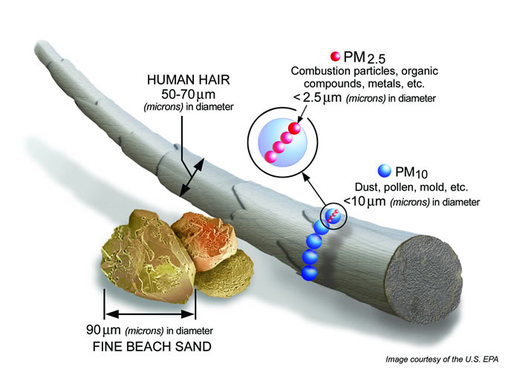
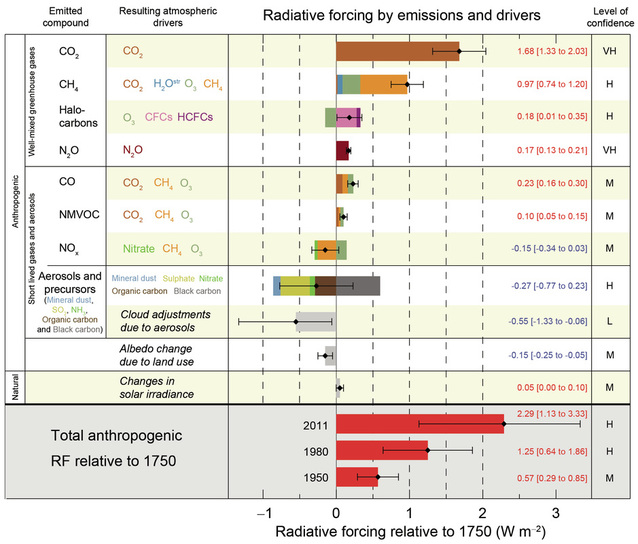
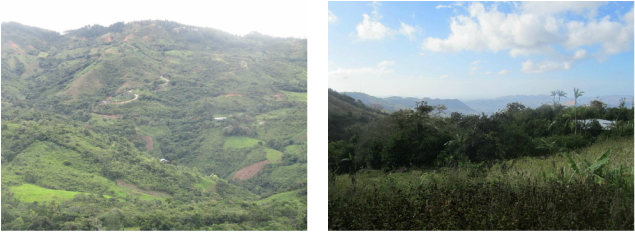
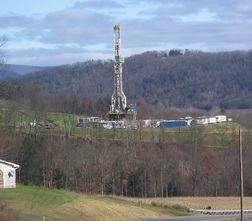
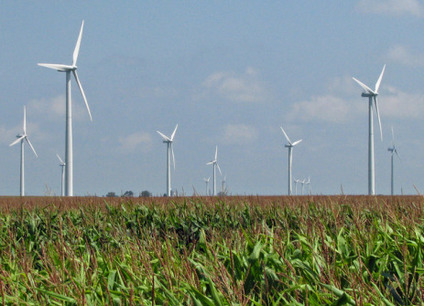
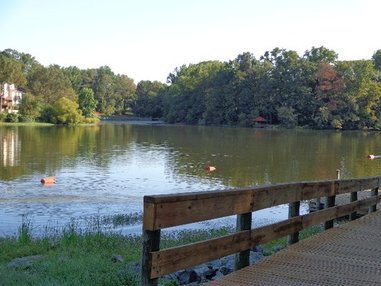
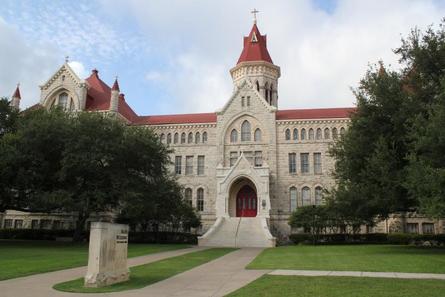
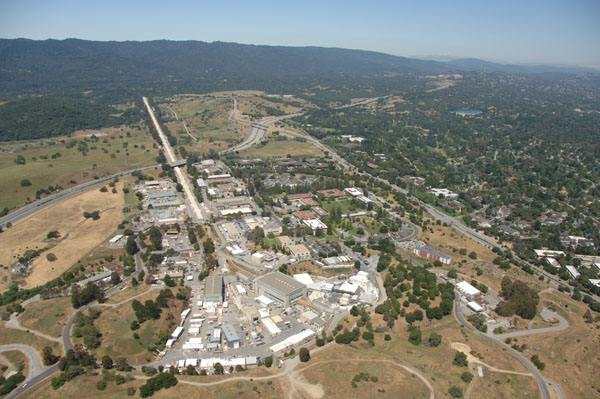
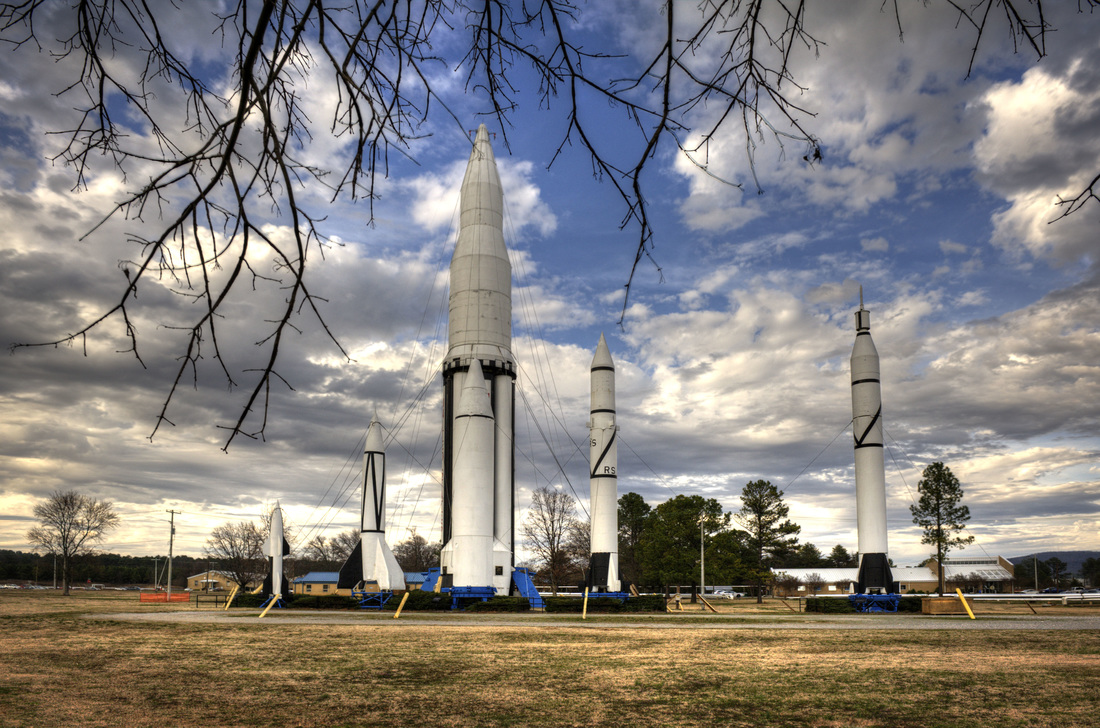
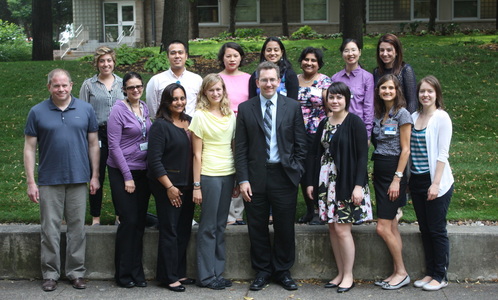
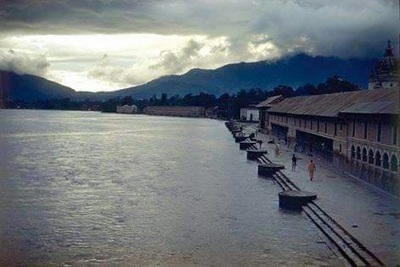
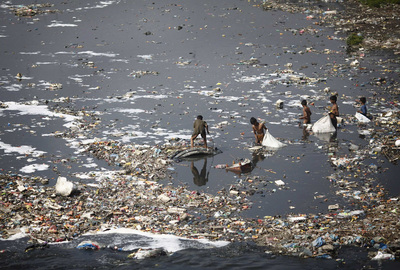
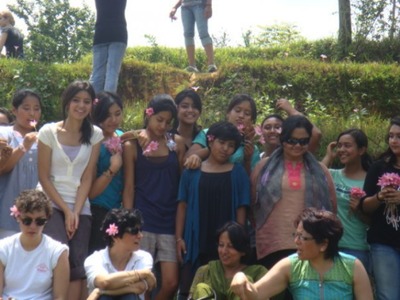
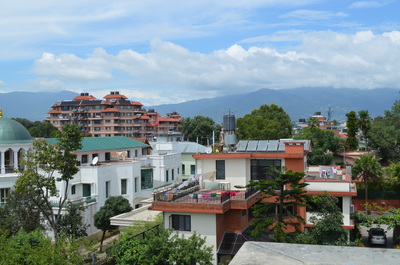
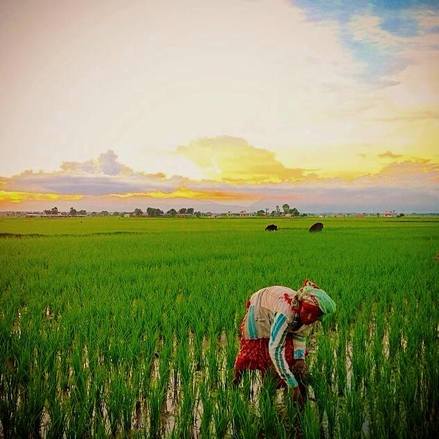
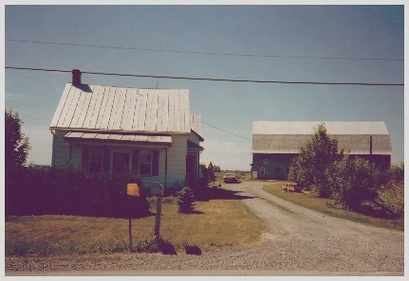
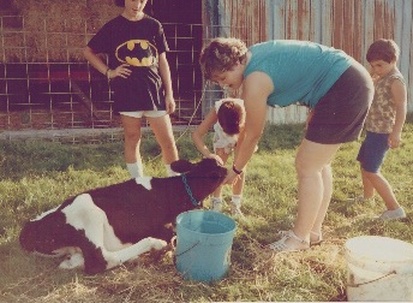
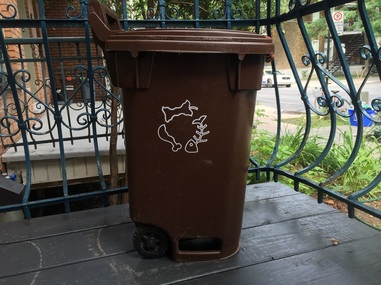
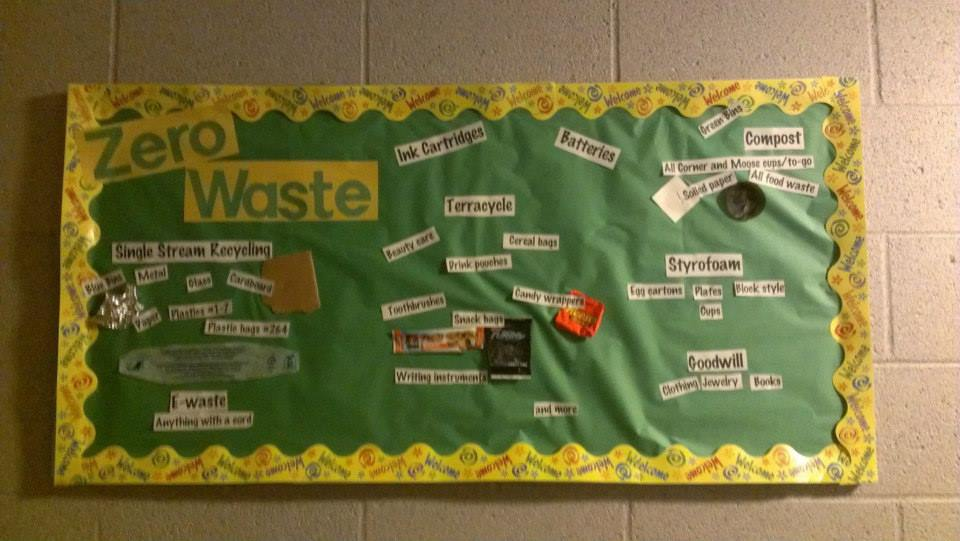
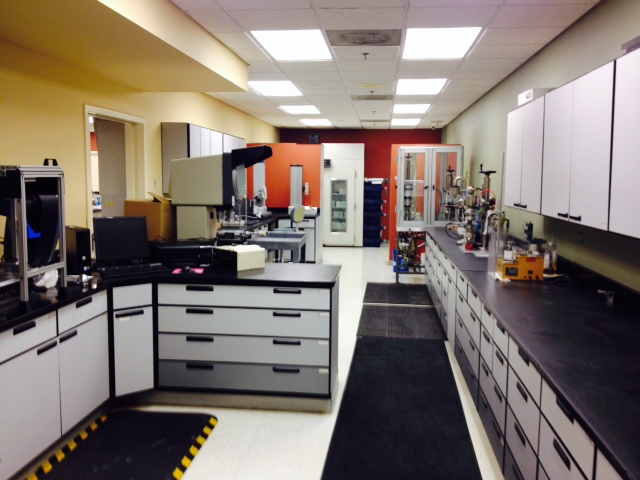
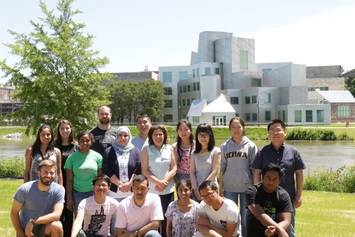
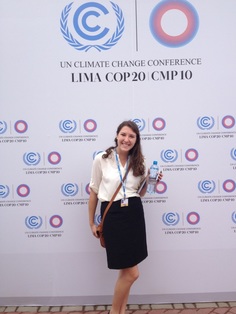
 RSS Feed
RSS Feed
